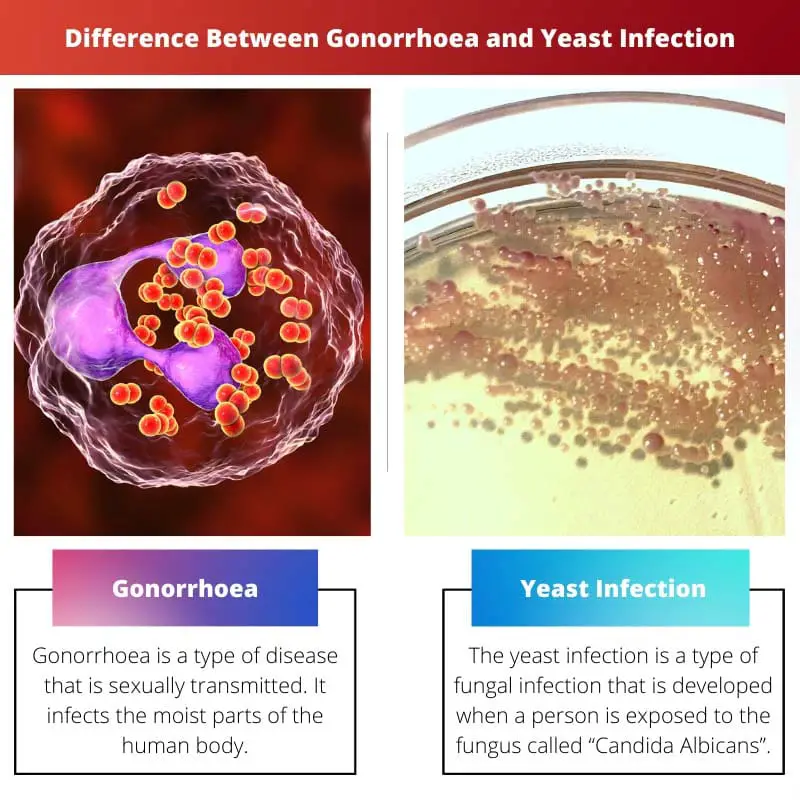Today, several types of health diseases lead to physical or mental agony for people. These disorders are either less severe or more severe. They are either treatable or non-treatable.
These disorders are transmitted from several sources and activities that a human being does in his daily life. There are several contagious diseases, infections, sexually transmitted diseases etc. Two of those are 1. Gonorrhoea, and 2. Yeast infection.
Key Takeaways
- Gonorrhea is a sexually transmitted bacterial infection, whereas yeast infections result from an overgrowth of the fungus Candida.
- Gonorrhea primarily affects the genital area and can lead to serious complications if untreated, while yeast infections cause itching and discomfort in the vaginal area.
- Treatment for gonorrhea involves antibiotics, whereas yeast infections are treated with antifungal medications.
Gonorrhoea vs Yeast Infection
Gonorrhoea is caused by the bacterium Neisseria gonorrhoeae, affecting the reproductive tract, like the cervix, uterus, fallopian tubes, and urethra in women, and the urethra, prostate and epididymis in men. Yeast infections are caused by the fungus Candida and are not considered a serious threat.

Gonorrhoea is a type of bacterial infection that is sexually transmitted to human beings. It is caused by the bacteria “Neisseria gonorrhoeae”. The most commonly targeted body parts of this infection are the eyes, throat etc.
These are some of the moist body parts which are most likely to get affected.
The human body is home to various bacteria and fungi. These organisms thrive on the human skin; some are dangerous while others are not. A yeast infection is caused due to the harmful growth of fungus in the human body.
The most commonly targeted body parts are the eyes, mouth etc.
Comparison Table
| Parameters Of Comparison | Gonorrhoea | Yeast Infection |
|---|---|---|
| Type | Bacterial infection | Fungal infection |
| Spread by | It is caused due to a a bacterium called “Neisseria gonorrhoea”. | It is caused due to the a fungus called “Candida Albicans”. |
| Also known as | No other name | Candidiasis, Moniliasis |
| Treatment | Prescribed antibiotics | Prescribed antimyotics |
What is Gonorrhoea?
Gonorrhoea is a type of disease that is sexually transmitted. It infects the moist parts of the human body. It is a type of bacterial infection, and the bacterium that causes this infection is called “Neisseria gonorrhoea”.
One can get infected with this disease through several modes of infection.
The symptoms of gonorrhoea are seen in a person after nearly two to fourteen days of exposure to the bacterium. These symptoms are either noticeable or unnoticeable.
But even if a person does not show any symptoms, they might pass the infection to somebody else. This type of gonorrhoea is known as asymptomatic gonorrhoea.
The most common initial symptom that is seen in men is acute pain and burning translation during urination. Other than that, they also experience constant sore throat, swelling, redness and pain in the genitalia, constant urge to urinate etc.
Even after the disease is treated, these symptoms persist in the body for a few days.
In women, the symptoms are difficult to diagnose, and thus it leads to other infections. The other symptoms include unusual discharge, spotting, painful menstrual cycles, acute abdomen pain, mostly in the lower area, soreness in the throat etc.
In some cases, women also experience fever. If gonorrhoea is not treated in women, then the risks of the infection reaching the uterus and thereby affecting the reproductive system.
The treatment of gonorrhoea includes the consumption of prescribed antibiotics. These antibiotics are either injected or taken by mouth.
One must always make sure that they do not have any sexual contact with the person that shows any symptoms of gonorrhoea and vice-versa. People must also keep their bodies clean and maintain proper hygiene.
These are the few steps that one may take to prevent gonorrhoea.

What is Yeast Infection?
The yeast infection is a fungal infection that develops when a person is exposed to the fungus called “Candida Albicans”.
The human skin contains bacteria that are not harmful and yeast cells, and the quantity of these two components must be balanced, and if the amount of yeast cells increases, it results in yeast infection.
The body parts in human beings that have warm temperatures and are moist are more likely to get infected.
Suppose a person has a weak immune system, diabetes, hormonal imbalance during or before menstrual cycles, or excessive intake of antibiotics. In that case, he or she is more likely to catch a yeast infection.
More than men, women are more like to experience a yeast infection. A yeast infection is one of the most common types of yeast infections that many women experience at least once in their lives.
Newborns are also prone to face yeast infections due to overuse of diapers that eventually cause rashes on their skin. They can also experience yeast infections in the armpits.
Men are also likely to face yeast infection, but the chances are less. However, the most common type of yeast infection that men face is the penile yeast infection.
Many symptoms of yeast infection in men include redness and swelling on the affected area and extreme inflammation.
Proper hygiene must be maintained, and safer sex practices are advised to prevent the spread of yeast infection in both men and women.
Main Differences Between Gonorrhoea and Yeast Infection
- Gonorrhoea is a type of sexually transmitted disease that is a bacterial infection, on the other hand, yeast infection is a type of disease that is sexually transmitted but is a fungal infection.
- Gonorrhoea is spread on the affected area when it is exposed to bacteria, on the other hand, yeast infection is spread on the affected area when the yeast cells in the skin are increased.
- The bacteria that causes gonorrhoea is known as “Neisseria Gonorrhoea”, on the other hand, the fungus that causes yeast infection is known as “Candida Albicans”.
- The symptoms of gonorrhoea include a burning sensation during urination, unusual discharge etc, on the other hand, the symptoms of yeast infection include unusual and malodorous discharge, excessive itching etc.
- Gonorrhoea is treated by consuming the prescribed antibiotics, on the other hand, yeast infection is treated by antimycotics.

- https://books.google.com/books?hl=en&lr=&id=dc7sCAAAQBAJ&oi=fnd&pg=PP6&dq=gonorrhea&ots=uGimOY_66J&sig=422EZ8XvWoiiL_xQ3wyMVMzYzY0
- https://www.sciencedirect.com/science/article/pii/S0196064495701680

It is good that the article explains the differences between the two diseases
I believe that gonorrhea could be eradicated with the proper measures
This article is an informative guideline for avoiding the diseases
Gonorrhea is a very serious disease and I think it should not be compared to yeast infection
It is interesting to read the different symptoms in men and women
Interesting article